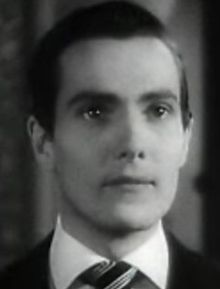Hurd Hatfield
Hurd Hatfield | |
|---|---|
 from the trailer for The Picture of Dorian Gray (1945) | |
| Born | William Rukard Hurd Hatfield |
William Rukard Hurd Hatfield (December 7, 1917 – December 26, 1998) was an American actor.
Biography
Hatfield was born in New York City, and was educated at Columbia University before travelling to London, England where he studied drama and began acting in theater. He returned to America for his film debut in Dragon Seed (1944).
Career
His second film, The Picture of Dorian Gray (1945), is arguably the film he is best remembered for. As Oscar Wilde's ageless hero, Hatfield received widespread acclaim for his good looks as much as for his acting ability.
His subsequent films, The Diary of a Chambermaid (1946), The Beginning or the End (1947), and The Unsuspected (1947) were successful, but Hatfield's career began to lose momentum very quickly.
His other films include Tarzan and the Slave Girl (1950), King of Kings (as Pontius Pilate) (1961), El Cid (1961), Harlow (1965), The Boston Strangler (1968), King David (1985), Crimes of the Heart (1986), and Her Alibi (1989).
He also appeared frequently on television and received an Emmy Award nomination for the made-for-television movie The Invincible Mr. Disraeli (1963). Among his many television credits are three guest appearances on Murder, She Wrote opposite his The Picture of Dorian Gray costar, Angela Lansbury, who had become a lifelong friend, and who also had a home in County Cork.
In 1966 he appeared on the television series The Wild Wild West in an episode entitled The Night of the Man-Eating House. In a twist on his Dorian role his character start as a creaky old man who, upon entering a house inhabited by the ghost of his mother, was turned back into a youthful Confederate soldier.
In his later years Hatfield was noted for his youthful appearance, and in interviews would joke about the picture he was hiding in his attic, in reference to Dorian Gray.
According to the magazine Film in Review, Hatfield was ambivalent about Dorian Gray, feeling that it had typecast him. "You know, I was never a great beauty in Gray," he is reported to have said, "and I never understood why I got the part and have spent my career regretting it."[1]
Private life
Having been introduced to Ireland by his friend Angela Lansbury, Hatfield lived at Ballinterry House Rathcormac, County Cork, Republic of Ireland from the early 1970s. A keen collector of antiques and art, he referred to Ballinterry House as a painting when he would never quite finish. He died peacefully in his sleep at the country home he loved so much of a heart attack, aged 81, after having had Christmas dinner with friends.
Both his home, Ballinterry House and his collection were inherited by his long time close friend and colleague Maggie Williams, who maintained the historic Irish country home exactly as it was at the time of Hatfield's death. The house was sold at the end of 2006 and the entire contents of the 'Hurd Hatfield Collection' was sold at an on the premises 'Country House Antique & Fine Art Auction' in March 2007.
References
- ^ Don Bachardy (1985). "Camp David". Films in Review. Retrieved 2007-09-05.
